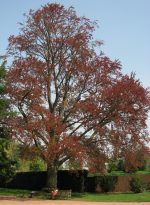 Purple beech is a deciduous tree resulting from a natural mutation of European beech (F. sylvatica), that is native to most of Europe from southern Sweden to northern Sicily and from northern Portugal and central Spain to northwest Turkey. Beach is a member of the Fagaceae that also includes oak and chestnut. The trees are large, growing up to 60′ tall and 40′ wide, and have smooth gray bark and a pyramidal to rounded crown. The broadly elliptical leaves are 2-4″ long and are fringed with silky brown hairs. They are purple when they first emerge but become green in the summer and turn coppery in the fall. Yellow-green male and female flowers appear on the same tree in mid to late spring. The male flowers are in tassel-like catkins that hang from the ends of the twigs while the female flowers grow in pairs. Fertilized female flowers give way to bristly fruits that are edible. Since the tree is very large and its branches reach to the ground, it is suitable as a specimen tree in a large area. Trees can be pruned to form an attractive hedge. The genus name, Fagus, is the Latin name for one species. The specific epithet, sylvatica, comes from the Latin word silva, meaning forest, and refers to the natural habitat of the tree.
Purple beech is a deciduous tree resulting from a natural mutation of European beech (F. sylvatica), that is native to most of Europe from southern Sweden to northern Sicily and from northern Portugal and central Spain to northwest Turkey. Beach is a member of the Fagaceae that also includes oak and chestnut. The trees are large, growing up to 60′ tall and 40′ wide, and have smooth gray bark and a pyramidal to rounded crown. The broadly elliptical leaves are 2-4″ long and are fringed with silky brown hairs. They are purple when they first emerge but become green in the summer and turn coppery in the fall. Yellow-green male and female flowers appear on the same tree in mid to late spring. The male flowers are in tassel-like catkins that hang from the ends of the twigs while the female flowers grow in pairs. Fertilized female flowers give way to bristly fruits that are edible. Since the tree is very large and its branches reach to the ground, it is suitable as a specimen tree in a large area. Trees can be pruned to form an attractive hedge. The genus name, Fagus, is the Latin name for one species. The specific epithet, sylvatica, comes from the Latin word silva, meaning forest, and refers to the natural habitat of the tree.
Type: Deciduous tree
Outstanding Feature: Purple foliage
Form: Pyramidal to rounded
Growth Rate: Rapid
Bloom: Yellowish green male and female flowers on the same tree in mid to late spring
Size: 50-60′ H x 30-40′ W
Light: Full sun to part shade
Soil: Rich, moist, well-drained; does not tolerate wet, poorly drained-soil.
Hardiness: Zones 5-7
Care: Low maintenance
Pests and Diseases: Generally healthy but susceptible to damage by aphids, borers, beech bark disease
Propagation: Grafting
Photo Credit: Wikipedia